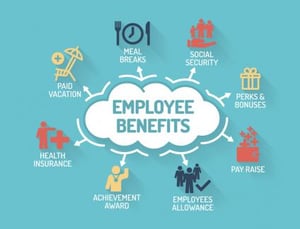How To Create A Competitive Benefits Package
As the war for top talent heats up, companies will have to work harder to recruit and retain the most desirable new hires. A strong benefits package can make the difference for job candidates trying to decide between your company and your competitor. But do you know what it takes to create a competitive benefits package?
Do Your Homework
Creating a competitive benefits package starts with information gathering:

- Survey your current employees to see if you’re offering the kind of benefits they want.
- Research your industry and competitors to find out what types of benefit offerings you’re up against.
- Look at your company culture and staffing needs to determine what kinds of employees you want to hire. Then explore what type of benefits those types of candidates are looking for.
"Your benefits broker is a good place to start looking for information on what your competitors might be offering," says Chris Costello, principal and founder of CBG Benefits. But you should also keep an eye out for local industry-specific HR networking groups, which often conduct benefits bench-marking surveys and share the results with members.
"It’s also important to take an honest look at whether your benefits program aligns with your company’s stated values," Costello says. For example, if your employer branding says your company promotes work-life balance and employee wellness, do your benefit offerings reflect that?
"Making sure they do may include ensuring you’re offering a competitive amount of paid time off and running a formal workplace wellness program throughout the year," Costello says. “It may also mean that you need to train your managers on the importance of these initiatives, and to help them encourage their employees to really take advantage of these programs.”
"Surveying employees can help you decide what kind of benefits they’re most interested in having, and it’s also important to track the benefits problems that are brought up to HR," Costello says. This information can be valuable when it comes time to make decisions about what benefits you’ll offer in the future.
While it’s unlikely you’ll be able to offer everything employees would like, asking what they’d like in an ideal world can start a dialogue about your benefit offerings. Be sure to remind employees that you’ll be using their feedback as you make decisions about the company’s benefit packages.
Evaluate Your Basic Offerings
Health insurance, paid time off and retirement plans are among the most common employee benefit offerings, and it’s hard to build a competitive benefits package without them.
Health Benefits
More employers are required to provide health insurance under the Patient Protection and Affordable Care Act. But now that greater numbers of people have access to health insurance, it’s harder for employers to stand out simply by offering a plan as part of their employee benefits.
"Leading employers are looking beyond just offering basic health insurance and focusing on delivering specific health care services," says Bill Carew, senior vice president of Digital Benefits Advisors. “Concierge medicine, for example, has replaced executive medical plans as a high-impact benefit that allows an employer to invest in the health and effectiveness of top performers while providing company executives with access to top-tier physicians.”
"There’s also been a surge in offering telemedicine options for employees across the board," Carew says. This provides them with better access to top-tier physicians as the shortage of primary care providers intensifies. “In both of these examples, employers are providing employees with a benefit that delivers direct care, not just insurance,” Carew explains. “Culturally, it's a win-win strategy that rewards employees with a benefit they value while investing in the health of key employees and reducing the total cost of care.”
Paid Time Off
 You’re not required by law to offer paid vacation time, but it’s an important part of a competitive benefits package. "Two to three weeks per year is fairly standard," Costello says, "while some companies are moving to an unlimited PTO model."
You’re not required by law to offer paid vacation time, but it’s an important part of a competitive benefits package. "Two to three weeks per year is fairly standard," Costello says, "while some companies are moving to an unlimited PTO model."
This approach may create buzz for your employee recruitment efforts, but it can also bring challenges. Some companies have found employees end up taking off even less time than they did when they had a set number of days off, and not getting as much out of the benefit as they could.
Communicating the importance of taking time off can help. “Employees need to believe that the upper level of the company’s management team really believes in the benefits of time off, and that they want their employees to take it,” Costello says.
Other attractive time-off options include paid sick leave, which is mandated in some jurisdictions, and paid or unpaid sabbaticals. Only 4% of companies in a 2011 SHRM employee benefits survey offered paid sabbaticals, while 15% offered unpaid. By contrast, about a quarter of the companies on Fortune’s 100 Best Companies to Work in 2012 offered full paid sabbaticals.
Retirement Plans
“Employees in today's job marketplace have come to expect that employers of choice will offer a 401(k) retirement plan,” says Jillienne Allgauer, HR expert with Paychex.com. She says the advantages of offering a retirement plan are the “3 Rs: recruitment, retention and relief, tax relief.” Employees get a tax break because they can use pretax dollars to make contributions to a 401(k).
Allgauer recommends making your company’s plan attractive and easy to use by offering features that employees want, such as mobile access to plan information, investment flexibility and accessible assistance — personalized, if possible.
Consider Voluntary Benefits
Voluntary benefits are a great way to provide employees with a wider variety of benefits without having to pay too much for them. Offering dental and vision benefits, long and short term disability insurance, life insurance and other voluntary benefits helps employees protect their health and financial well-being.
"As some employers shift to high-deductible health insurance plans, voluntary benefits are a popular way to fill the gap," says Dawn McAbee, corporate communications manager at Unum. “Employees tend to react more favorably to high-deductible health plans when they also have access to affordable voluntary benefits. Products like accident, critical illness, group hospital indemnity and disability provide employees additional financial protection that they need to help fill in the gaps that medical coverage does not cover.”
"Voluntary benefits are an attractive option for employers, as they work with almost any budget," McAbee says. Employers may pick up some or all of the cost, or employees themselves may pay only for the benefits they want. Even when employees pay the full cost, they usually save money over the cost they would have had to pay for the same coverage on the open market. McAbee continues, "Employees are more satisfied with their workplaces when employers offer voluntary benefits."
Look For Ways to Stand Out
Progressive companies that want to make their benefits packages even more competitive can consider a wider variety of options for employees.
Relocation Assistance

"There is an abundance of people in the job market willing to relocate for a new position, and providing relocation assistance can help companies bring the best of that talent on board," says Michael Krasman, CEO of UrbanBound.
Relocation assistance can also be effective if the salary you’re offering is a little lower than the new hire had hoped. A strong relocation package is a benefit that allows companies to search for talent outside of their region and tip the scales for candidates who may have been wary of the headache of moving.
Flexible Work Schedules
While flexible work schedules are a popular employee benefit, Paul Rupert, president of Rupert & Co., says it’s important not to try to manage them the same way you do other benefits. "Managers don’t have to do anything to get health insurance taken care of," he explains, "but flexible work schedules require good managing. Employees may want to start their shifts earlier or later, take longer lunches, or work four 10-hour days a week. That can work, but it will require more coordination than having everyone operating on the same schedule."
Kyra Cavanaugh, president of Life Meets Work, says it’s important for employers to know that offering flextime is a benefit to the company as well. “Managers think they’re doing this to be nice, when, in fact, 20 years of research has proven that flextime improves health and well-being, profitability, customer service, engagement and productivity. It’s not about being nice; it’s about improving the business.”
Remote Work
"Some employers don’t want to offer flextime because they’re afraid it means working at home —and they’re not ready for that," Cavanaugh says. But the flexible schedules described above are the perfect way to give employees a little more autonomy until managers are ready for remote working.
“People need more feedback in these arrangements,” Rupert says. “They’re going to be apprehensive, because they’re not around as much, so they tend to get less feedback than someone in the office.”
As people use technology to work seamlessly at a location other than the office, Cavanaugh says it’s important to look at flexible work arrangements as an imperative, not a benefit. As technology continues to advance, flexible work will continue to grow, making it easier for employers to hire top talent wherever it may be. “The sooner we recognize this isn’t something optional, then it starts to remove the stigma and fear,” she says.
"Putting together a competitive benefits package will help you retain your best employees and recruit the top talent your company needs to thrive. Making an authentic effort to match your benefits to your values is key," Costello says. “With the rise in popularity of social media and websites such as Glassdoor, this is more important than ever. No matter what your corporate website may say you do, your employees now have a channel to share what they see is really happening inside your organization.”
EbixMarketing


